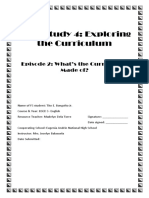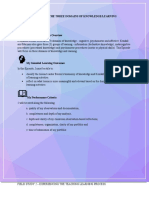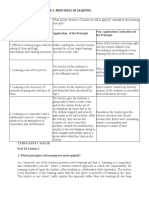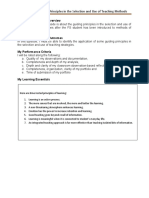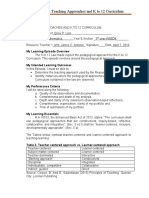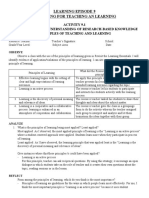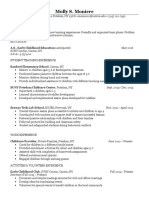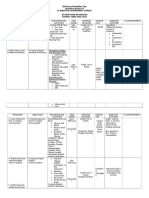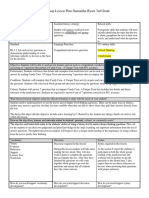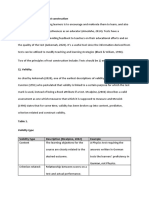Learning Episode 3
Learning Episode 3
Uploaded by
Jemmuel SarmientoOriginal Description:
Original Title
Copyright
Available Formats
Share this document
Did you find this document useful?
Is this content inappropriate?
Report this DocumentCopyright:
Available Formats
Learning Episode 3
Learning Episode 3
Uploaded by
Jemmuel SarmientoCopyright:
Available Formats
LEARNING EPISODE 5 – TEACHING APPROACHES AND THE K to 12 CURRICULUM
My Learning Episode Overview
The K to 12 Law made explicit the pedagogical approach for the K to 12 Curriculum. This Episode
revolves around this pedagogical approach.
My Intended Learning Outcomes
In this Episode, I must be able to:
determine the teaching approach used by the Resource Teachers
identify instances where the pedagogical approaches of the K to 12 Curriculum contained in the
law are observed
My Performance Criteria
1 will be rated along the following:
a. quality of my observations and documentation,
b. completeness and depth of my analysis,
c. depth and clarity of my classroom observation-based reflections,
d. completeness, organization, clarity of my portfolio and
e. time of submission of my portfolio.
FIELD STUDY 2 – EXPERIENCING THE TEACHING LEARNING PROCESS
My Learning Essentials
R.A. 10533, the Enhanced Basic Education Act of 2013, states: "The curriculum shall use
pedagogical approaches that are constructivist, inquiry-based, reflective, collaborative, and integrative".
(Sec. 5 e) It shall be "learner-centered, inclusive, developmentally appropriate". (Sec. 5 a).
The tables below contrast teacher-centered and learner-centered approach to teaching-learning
Table 3. Teacher centered approach vs. learner-centered approach
Teacher-centered Learner-centered
Subject matter-centered Learner-centered
Teacher-dominated Interactive
"Banking approach" Constructivist
Disciplinal Integrated
Individualistic, competitive Collaborative
Indirect, guided Direct
Source: Corpuz, B. and G. Salandanan (2013) Principles of Teaching Quezon City: Lorimar Publishing
Table 4 Teacher centered approach vs. learner-centered approach
Teacher-centered Approach Learner-centered Approach
Knowledge is deposited by teacher in the minds Learners construct knowledge by receiving
of students (banking system'); teacher is the only information from teacher and integrating it with
expert and the only source of information their experiences and prior information
(constructivist)
Emphasis is on subject matter for the test. Emphasis is on using knowledge learned to solve
problems in real life contexts
Teacher dominates class proceedings. Students are actively involved in learning
activities.
Focus is on single discipline. Makes use of interdisciplinary and
multidisciplinary approach.
Culture is individualistic and highly competitive Culture is cooperative, collaborative and
supportive
Only students are viewed as learners Teachers and learners learn together.
FIELD STUDY 2 – EXPERIENCING THE TEACHING LEARNING PROCESS
Remembering
My Learning Activities
I will observe one Resource Teacher with the use of an Observation Sheet for greater focus. I will analyze
my observations with the help of guide questions then reflect on my observations and analysis.
OBSERVATION SHEET # 5
Resource Teacher: Teacher Julie Abad Teacher's Signature: ______________ Date: Oct. 25, 2021
School: Woodfield Academy of Bataan Grade/Year Level: Grade II Subject Area: Reading
Teacher-centered Student-centered
Did teacher lecture all the time? Were students involved in the teaching-learning
process? How? Or were they mere passive
recipients of instruction?
Teacher Julie gives a lecture while also The pupils are actively participating in the
engaging the students in activities. discussion. They were engaged students who
actively participated in class discussions and
learning activities.
Was the emphasis mastery for the lesson for the Was the emphasis the students' application of the
test? Prove. lesson in real life? Give proofs.
The emphasis of the lesson is most likely on Teacher Julie inspired her students to apply
the test as well as when they apply it in real what they had learned in class to real-life
life. When a teacher gives a test to a student, situations. She listened to the pupils'
especially in reading practice, she can tell if reflections on the value of reading in
the student has mastered reading. The everyday life.
importance of studying the lesson and the
benefits it may bring to the students' lives is
always reinforced by the teacher.
Was class atmosphere competitive? Why. Was class atmosphere collaborative? Why?
Yes, where all of the pupils were fully The pupils cooperate and collaborate with
engaged in class activities while also one another in a variety of activities that
participating in the class discussion. They are foster a sense of connection. They are also
very eager to answer Teacher Julie’s assisting one another in responding to the
questions. teacher's inquiries.
FIELD STUDY 2 – EXPERIENCING THE TEACHING LEARNING PROCESS
Teacher-centered Student-centered
Did teacher focus only on one discipline/subject? Did teacher connect lesson to other
disciplines/subjects?
A behavioral approach is one in which The teacher incorporated the subject matter
teacher Julie emphasizes discipline prior to, into other lessons, allowing students to
during, and after the session. She used a readily absorb the content.
variety of themes to incorporate her lecture,
making it easier for the kids to follow along.
What teaching-learning practice show that teaching approach was:
a) constructivist-connected to past experiences of learners; learners constructed new lesson meanings
Teacher Julie provides pupils with an opportunity to participate actively in class discussions.
Throughout the class discussion, the teacher encourages students to relate their prior experiences
to the topic and makes an attempt to connect them to the new idea under discussion.
b) inquiry-based
The teacher begins with an open-ended question that requires pupils to think critically in order to
prepare them for the lesson.
c) developmentally appropriate-learning activities fit the developmental stage of children
She enhanced the courses with relevant, varied examples and online resources connected to the
subject topic, allowing learners or students to develop their cognitive thinking skills.
d) Reflective
The resource teacher is reflective because, as I observe, she is aware of what she teaches and how
it benefits the learners. She is very well aware that she will educate primarily to improve her
students.
e) inclusive - No learner was excluded; teacher taught everybody.
There is no bias in the teacher's treatment of all students. She encouraged all of her students,
regardless of their differences, to actively participate in class discussions and learning activities.
f) collaborative - Students worked together.
She suggested activities that required collaboration, such as partner activities.
g) integrative - Lesson was multidisciplinary - e.g. In Science, Math concepts were taught.
She is a teacher who integrates and connects several lessons to other subject matter so that the
students may learn and understand what the text is all about. Also, as a result of this, students'
minds will no longer be stuck in one subject but will be able to explore varied interesting subjects.
FIELD STUDY 2 – EXPERIENCING THE TEACHING LEARNING PROCESS
My Analysis
1. Based on your observations, as a whole was instruction teacher-centered or student centered?
As a whole, a classroom operates on the principle of student-centered instruction, with
students and instructors working together to achieve the goal. Instead than solely listening to the
teacher, pupils and teachers engage in conversation on an equal basis. Students learn how to
cooperate and communicate with one another through collaborative learning, which are
encouraged.
2. Were there instances when the students could have been involved in class proceedings but were
not? Give example/s.
There were no situations in which the students were not engaged in the lesson because
the resource teacher asks her students questions from time to time throughout the discussion. The
students are involved in practically every aspect of the exercise, from her discussions to
answering instances on the online whiteboard and reciting the procedure or stages after the
subject has been presented.
3. What are possible consequences of teaching purely subject matter for mastery and for the test?
The kids will be restricted to the four corners of the classroom, and their learning will not
extend to the outside world since they will be flooded with concepts but no application. Students
will study solely for the purpose of exams, and everything the teacher has taught will be forgotten
quickly.
4. If you were to reteach the class, would you be teacher-centered or student-centered? Why?
If I were going to reteach the class, I would be teacher centered. Why? Because my main
concern as an educator is children learn best when they enjoy learning. I want to teach my
students how to develop and attain personal and educational objectives. I will assure that the
strategies and methods that I am going to use will help them develop their critical thinking and
self- reflection skills. As a learning facilitator, I will allow my pupils to serve as their own
advocates in the learning process.
5. If you abide by the pedagogical approaches that the K to 12 Law states, will you be more teacher-
centered or student-centered in approach? Explain your answer.
Yes, I will focus more on a student-centered strategy that encourages students to
participate more actively in class discussions and actively participate in learning activities that
will help them develop and expand their skills, knowledge, and talents. When it comes to
brainstorming or sharing ideas with one another, this type of method involves collaborative
learning, in which students work in teams or groups. I truly believed that student-centered
classrooms are more advantageous to student learning since they allow students to learn via
FIELD STUDY 2 – EXPERIENCING THE TEACHING LEARNING PROCESS
doing, communicate, and conduct their own research, among other things.
My Reflections/Insights
Between teacher-centered and student-centered approach, the latter must be more pedagogically
sound because even R.A. 10533, the Enhanced Basic education Act of 2013, mandates it for K to 12.
Write your reflections about it. Or is it better to use both approaches?
Student-centered classrooms, as we all know, divert the attention away from the teachers and
toward the students, who are encouraged to take responsibility for their own learning. Providing several
opportunities for student reflection is one way to assist students in learning to accomplish this. Students
must reflect on something they have done by giving it substantial thought or consideration. It aids in the
development of their ability to make decisions when solving problems. It also fosters mental flexibility.
Teachers are the source of learning, so we must respect them as our second parents; they devote
their time to instructing students; without them, we would not be able to learn, and perhaps there would
be no professionals today; they teach us values, discipline, and knowledge because it is their mission to
guide us from their expertise.
The learner is at the center of the curriculum; we are constantly interested in learning knowledge,
and as constructivists, we must unlock the knowledge that exists within our minds. Teachers just integrate
us with existing knowledge. Cooperative, collaborative, and disciplined learners are required.
Using both approaches, in my opinion, may be problematic given today's learners' complexity
and attachment to technology. We only have to pick one, and I advised using a student-centered approach
to teaching. Student-centered instruction is considerably superior to teacher-centered teaching since it
focuses more on the child's ability to learn and understand. You must address every facet of that learner's
needs.
FIELD STUDY 2 – EXPERIENCING THE TEACHING LEARNING PROCESS
My Learning Portfolio
1. With a graphic organizer, present the pedagogical approaches to the K to 12 Curriculum
as stated in RA 10533. Give the main features of each approach.
Source: https://morganmittelbrunmatltportfolio.weebly.com/project-1-supporting-the-
needs-of-all-learners.html
2. A student-centered approach is very interactive. Research on at least 3 teaching - learning
activities techniques that can be used at the beginning or end of a lesson.
Put them here.
Source: https://slidetodoc.com/using-learning-outcomes-in-teaching-learning-and-assessment/
FIELD STUDY 2 – EXPERIENCING THE TEACHING LEARNING PROCESS
LEARNING EPISODE 6– DEDUCTIVE AND INDUCTIVE METHODS OF TEACHING
My Learning Episode Overview
After a Learning Episode on Teaching Learning Approach, the FS student gets acquainted with
methods of teaching. A teaching method is the practical realization or application of an approach.
My Intended Learning Outcomes
At the end of this Episode, I am able to:
identify the teaching method used by my Resource Teachers
distinguish between deductive (direct) and inductive (indirect) method of teaching
My Performance Criteria
1 will be rated along the following:
a. quality of my observations and documentation,
b. completeness and depth of my analysis,
c. depth and clarity of my classroom observation-based reflections,
d. completeness, organization, clarity of my portfolio and
e. time of submission of my portfolio.
FIELD STUDY 2 – EXPERIENCING THE TEACHING LEARNING PROCESS
My Learning Essentials
All methods of teaching can be classified either as deductive (direct) or inductive (indirect).
Deductive Method (Direct) Inductive Method (Indirect)
te,
les and
zation,
FIELD STUDY 2 – EXPERIENCING THE TEACHING LEARNING PROCESS
My Learning Activities
I will observe 2 classes by using Observation Sheets for greater focus then analyze my
observations with the help of guide questions. I will write down my reflections on my observations and
experiences.
OBSERVATION SHEET # 6.1
Resource Teacher: Teacher Jessica Maraviles Teacher's Signature: ______________ Date: Oct. 28, 2021
School: Woodfield Academy of Bataan Grade/Year Level: ________ Subject Area: Science
Observe how the Resource Teacher began, developed and ended her/his lesson.
Start of the lesson
Teacher Jessica started their lesson by recalling their previous activity regards to their lesson
which is they watched video entitled, “Phoenix Zoo”. Since its online learning, teacher Jessica
conducted an online tour to a zoo.
Development of her lesson
Based on the video they watched, teacher Jessica asked questions to her learners like what is their
favorite animal that mentioned in the video and why is it their favorite. Learners answered
different kinds of animals and share stories about it. She then gave an activity in which Grade II
pupils have to draw their favorite animal that can be found in a zoo.
Ending of her lesson
After the drawing activity, Teacher Jessica told her pupils to show their outputs in class. But, the
twist is they have to call one classmate to guess what animal they drew. After that, they have to
tell and discuss what are the characteristics of that animal. Teacher Jessica also asked her students
how animals are very important to us and one of her learners answered that animals are source of
our food and without food, we cannot survive.
FIELD STUDY 2 – EXPERIENCING THE TEACHING LEARNING PROCESS
OBSERVATION SHEET # 6.2
Resource Teacher: Teacher Julie Abad Teacher's Signature: ______________ Date: Oct. 27, 2021
School: Woodfield Academy of Bataan Grade/Year Level: Grade II Subject Area: Language
Observe how the Resource Teacher began, developed and ended her/his lesson.
Start of the lesson
Teacher Julie conducted an online community tour through displaying pictures of sari sari store,
plaza, basketball court and neighborhood. This strategy of hers is connected to their past lesson.
She then let her learners recall their previous discussion about “Singular Noun”. Teacher Julie
asked her students what is the meaning of singular noun. Her students answered, “It is an object or
a noun that is only one.” Teacher also showed some examples of singular noun with picture on it
for the learners to easily understand.
Development of her lesson
Through the use of their online learning platform, Peardeck, Teacher Julie now present the new
lesson which is all about “Plural Noun”. Teacher Julie asked her students if they have the idea
what plural noun is. One of her learners answered that it is a noun that refers to more than one of
something. The teacher now display the examples of plural noun and discussed the rules on how
nouns can be in a plural form. The first rule they discussed was to always add-s at the end of a
word.
Ending of her lesson
Teacher Julie provide an activity about applying the rule no. 1 of plural noun through Peardeck,
wherein learners have the control to manipulate the screen. Its an online interactive whiteboard,
learners will answer via typing or writing their answer through pens or brushes available on the
online learning platform they are using. Teacher Julie monitors the answers of her learners and the
activity they are doing on the screen because its one of the features of that online leaning app.
FIELD STUDY 2 – EXPERIENCING THE TEACHING LEARNING PROCESS
My Analysis
6. Did the Teachers use the deductive or inductive method? Prove your answer.
The teachers used both deductive and inductive method. Teacher Jessica used deductive method
in a way that she first provide a video about animals in a zoo. She let her learners realized what are these
animals that can be found in that place. She also told her students to write down all the animals that will
mention in the video. The teacher introduces a new topic to the pupils, explains it, and then has them
practice applying it.
On the other hand, teacher Julie had her inductive method. She start giving the details and
concrete examples of plural nouns. She let the students to respond to her by asking questions to them.
Then, she discussed the rules of plural noun. Finally, the students will put the concept into application in a
multitude of ways.
7. In which teaching method were students more involved in the teaching-learning process?
The inductive method, in my perspective, is the finest method for including students in the
teaching-learning process because it is a discovery method that trains the mind, builds self-confidence,
and encourages students to participate more actively.
8. Which method had greater demand from the teacher in terms of questioning and organizing
skills? Why?
The approach that received the most demand from teachers is the inductive method, as a teacher's
response to a student's response is just as crucial as the question itself. When an inaccurate answer is
provided or when students misunderstand the question, a response may guide pupils. The teacher enables
students to acquire not only content knowledge, but also how to analyze data and utilize it to reach
acceptable conclusions. Through the inductive technique, students gained first-hand knowledge and
information through actual observation.
9. Was there an instance when the teacher taught the lesson deductively/inductively when it could
have been better if she taught it inductively/deductively? Explain your answer.
There are instances where the teacher taught the lesson deductively/inductively by describing the
lesson and the students responded to the instructor; however, it would have been preferable if the teacher
taught the lesson inductively/deductively once the students understood the topic.
FIELD STUDY 2 – EXPERIENCING THE TEACHING LEARNING PROCESS
My Reflections/Insights
Which is more effective teaching method – deductive or inductive?
The importance of inductive and deductive language teaching and learning in education can really
be emphasized. They are two unique and opposed strategies or approaches to teaching and learning. A
teacher/instructor and a student/learner are required for both. The focus and flow of material, as well as
the responsibilities of the teacher and student, are the most significant variations between the two
systems. Inductive teaching and learning suggests that the flow of knowledge is directed from specific to
general, whereas deductive teaching emphasizes the teacher's function as the person who offers and
disseminates all information. In this procedure, information is passed from general to specific.
Inductive reasoning is more effective than deductive reasoning. Inductive teaching and learning
has numerous advantages: knowledge is learned spontaneously through exposure, and students are
encouraged to use their reasoning abilities, prior knowledge, intelligence, and mental focus. This method
also assesses a student's ability to make connections depending on the data supplied. It is easier for the
learner to learn the subject if it involves the student's perspective. This strategy allows for personalized
concepts that are easy to recall and comprehend. This is a way of discovery that might take a long time
and requires a lot of imagination and creativity on the part of the student.
FIELD STUDY 2 – EXPERIENCING THE TEACHING LEARNING PROCESS
My Learning Portfolio
Give one example for each teaching method - deductive and inductive. (e.g.
demonstration method for deductive method; discovery method for inductive method)
Inductive
Detailed Lesson
Plan in English-2 COMMON AND PROPER NOUNS.docx
Deductive
Detailed Lesson
Plan in Math-2 SHAPES.docx
Describe the specific steps of each example. Make use of graphic organizers.
FIELD STUDY 2 – EXPERIENCING THE TEACHING LEARNING PROCESS
You might also like
- FS 2 - Episode 4 The Taxonomy of Educational Objectives - The Levels of Learning ActivitiesDocument12 pagesFS 2 - Episode 4 The Taxonomy of Educational Objectives - The Levels of Learning ActivitiesHenry Kahal Orio Jr.100% (1)
- Field Study 4Document12 pagesField Study 4Son YongNo ratings yet
- Learning Episode 3 - The Three Domains of Knowledge/Learning ActivitiesDocument24 pagesLearning Episode 3 - The Three Domains of Knowledge/Learning ActivitiesJemmuel SarmientoNo ratings yet
- Observation Sheet No 2.1: PampangacollegesDocument5 pagesObservation Sheet No 2.1: PampangacollegesNicole Manansala UsiNo ratings yet
- FS 3 Episode 6Document7 pagesFS 3 Episode 6Mark Anthony Nieva RafalloNo ratings yet
- Episode 1 Principle of LearningDocument4 pagesEpisode 1 Principle of Learninglora antiguaNo ratings yet
- Observation-Sheet-9 JIMDocument6 pagesObservation-Sheet-9 JIMJim Russel SangilNo ratings yet
- Episode 3 On Content Validity of TestsDocument13 pagesEpisode 3 On Content Validity of TestsLeonilo C. Dumaguing Jr.No ratings yet
- FS 2 - Episode 3 THE THREE DOMAINS OF KNOWLEDGE - LEARNING ACTIVITIESDocument15 pagesFS 2 - Episode 3 THE THREE DOMAINS OF KNOWLEDGE - LEARNING ACTIVITIESHenry Kahal Orio Jr.100% (2)
- Episode 4Document14 pagesEpisode 4Kel LiNo ratings yet
- Field Study 2Document24 pagesField Study 2Joyce Ann Sarmiento Astejada100% (3)
- Field Study - Ep 2Document5 pagesField Study - Ep 2larenNo ratings yet
- Fs 3 and 4 MaeDocument46 pagesFs 3 and 4 MaeEvalyn M. SalvaNo ratings yet
- Episode 3: What'S New in Teaching and Learning?: My TargetDocument7 pagesEpisode 3: What'S New in Teaching and Learning?: My TargetNeil Patrick FloresNo ratings yet
- FS 6 Ep5 and Ep6Document30 pagesFS 6 Ep5 and Ep6Jesiemel55% (20)
- FIELD STUDY Episode 4 TOOLS OF THE TRADEDocument5 pagesFIELD STUDY Episode 4 TOOLS OF THE TRADEVaughn GaneloNo ratings yet
- Edfs 22 - Episode 1Document9 pagesEdfs 22 - Episode 1RestyNo ratings yet
- FS6Document2 pagesFS6Derrick SumNo ratings yet
- FS 2Document62 pagesFS 2Courtney Love Arriedo OridoNo ratings yet
- FS 2 Episode 3obe - The Three Domains of KnowledgeDocument11 pagesFS 2 Episode 3obe - The Three Domains of KnowledgeJustine Elle VijarNo ratings yet
- FS 4 Episode 5.Document7 pagesFS 4 Episode 5.Charles Kenn Mantilla65% (17)
- Observation-Sheet-3 JIMDocument7 pagesObservation-Sheet-3 JIMJim Russel SangilNo ratings yet
- Principles of LearningDocument3 pagesPrinciples of LearningJean MaltiNo ratings yet
- Episode 5 Table of Specification (TOS) Content Validity and Outcomes-Based Education (OBE)Document3 pagesEpisode 5 Table of Specification (TOS) Content Validity and Outcomes-Based Education (OBE)Blessildajoy Cruz100% (2)
- FS 5 Ep 5Document11 pagesFS 5 Ep 5nissi guingab90% (10)
- FS 2 - Episode 2 Intended Learning Outcomes Lesson Objectives As My Guiding StarDocument12 pagesFS 2 - Episode 2 Intended Learning Outcomes Lesson Objectives As My Guiding StarHenry Kahal Orio Jr.No ratings yet
- Episode 3Document11 pagesEpisode 3Mark Anthony Nieva RafalloNo ratings yet
- Fs 5 Episode 4Document25 pagesFs 5 Episode 4Sheila Mae Lucasan60% (5)
- Curriculum Evaluation and The Teacher: My FS Learning Episode OverviewDocument10 pagesCurriculum Evaluation and The Teacher: My FS Learning Episode OverviewMark Anthony Nieva RafalloNo ratings yet
- Effective Questioning and Reacting Techniques: My Performance (How I Will Be Rated)Document7 pagesEffective Questioning and Reacting Techniques: My Performance (How I Will Be Rated)Nelgen PiolaNo ratings yet
- Episode 1: The Teacher As A Person in Society: Joy Pasco Jingle Estoria Kimberly DiazDocument38 pagesEpisode 1: The Teacher As A Person in Society: Joy Pasco Jingle Estoria Kimberly DiazJoy Pasco0% (1)
- Episode 4 NewDocument9 pagesEpisode 4 NewMark Anthony Nieva RafalloNo ratings yet
- Learning Episode 5: Technology Integration in The ClassroomDocument5 pagesLearning Episode 5: Technology Integration in The ClassroomRona Grace Bigay LeonenNo ratings yet
- Local Media8975874012059344123 PDFDocument17 pagesLocal Media8975874012059344123 PDFPark Ji NieNo ratings yet
- Stakeholders in Curriculum Development: My FS Learning Episode OverviewDocument10 pagesStakeholders in Curriculum Development: My FS Learning Episode OverviewMark Anthony Nieva RafalloNo ratings yet
- FS 2 - Episode 7 Guiding Principles in The Selection and Use of Teaching MethodsDocument10 pagesFS 2 - Episode 7 Guiding Principles in The Selection and Use of Teaching MethodsHenry Kahal Orio Jr.No ratings yet
- Episode 4 Assessing Learning in Different LevelsDocument4 pagesEpisode 4 Assessing Learning in Different LevelsBlessildajoy CruzNo ratings yet
- Self-Assessment Can Also Provide Insight Into Students' True Comprehension and Can Help ToDocument3 pagesSelf-Assessment Can Also Provide Insight Into Students' True Comprehension and Can Help ToJessalyn RadaNo ratings yet
- Close Encounter With Retired TeacherDocument9 pagesClose Encounter With Retired TeacherHimari-chanNo ratings yet
- Reviewer CTPDocument4 pagesReviewer CTPCjls KthyNo ratings yet
- Looking Through The Meaningful Learning ExperiencesDocument3 pagesLooking Through The Meaningful Learning ExperiencesChlephz Dm57% (7)
- Field Study 5 Learning Episode 1. ASSESSDocument35 pagesField Study 5 Learning Episode 1. ASSESSAlyn Apolo LlenaNo ratings yet
- Field Study 2 Experiencing The Teaching Learning ProcessDocument70 pagesField Study 2 Experiencing The Teaching Learning ProcessDinoNo ratings yet
- Field Study 4Document2 pagesField Study 4JenniferNo ratings yet
- Fs MayenDocument30 pagesFs MayenKatniss CatnipNo ratings yet
- FS 6 Episode 5 and 6Document19 pagesFS 6 Episode 5 and 6maeroslim55% (33)
- FS E4 - AnsweredDocument7 pagesFS E4 - AnsweredSkaye MCNo ratings yet
- fs4 (Episode 1)Document9 pagesfs4 (Episode 1)Ces ReyesNo ratings yet
- FS 5 Episode 5Document5 pagesFS 5 Episode 5CezLuzarraga80% (5)
- Learning Episode 7Document7 pagesLearning Episode 7Cory Belleza Cruz75% (4)
- FS2 - Learning Episode 7 Guiding Principles in The Selection and Use of Teaching MethodsDocument10 pagesFS2 - Learning Episode 7 Guiding Principles in The Selection and Use of Teaching Methodssheilajanedlasala100% (1)
- Episode 7Document5 pagesEpisode 7Graciele Joie ReganitNo ratings yet
- Answer Sheet Educ 113 Module 2Document5 pagesAnswer Sheet Educ 113 Module 2RIAMAY APIADO100% (1)
- FS 4 ReflectionDocument2 pagesFS 4 ReflectionRomelo Muldez71% (7)
- Edfs 22 - Episode 2Document3 pagesEdfs 22 - Episode 2RestyNo ratings yet
- Implementing The Curriculum: The Teacher As Curriculum Implementer and ManagerDocument9 pagesImplementing The Curriculum: The Teacher As Curriculum Implementer and ManagerMark Anthony Nieva RafalloNo ratings yet
- Fs-1-Learning-Episode-4 2Document5 pagesFs-1-Learning-Episode-4 2Lapiz SheilaNo ratings yet
- Episode 5: Teaching Approaches and K To 12 Curriculum: My Learning Episode OverviewDocument12 pagesEpisode 5: Teaching Approaches and K To 12 Curriculum: My Learning Episode OverviewHenry Kahal Orio Jr.No ratings yet
- Learning Episode 9 Preparing For Teaching An LearningDocument5 pagesLearning Episode 9 Preparing For Teaching An LearningCrizel Mae EnovisoNo ratings yet
- Episode 5: Teaching Approaches and K To 12 Curriculum: My Learning Episode OverviewDocument12 pagesEpisode 5: Teaching Approaches and K To 12 Curriculum: My Learning Episode OverviewJustine Elle Vijar80% (15)
- Learning Episode 3 - Classroom Management and LearningDocument22 pagesLearning Episode 3 - Classroom Management and LearningJemmuel SarmientoNo ratings yet
- Learning Episode 6 - Deductive and Inductive Methods of TeachingDocument7 pagesLearning Episode 6 - Deductive and Inductive Methods of TeachingJemmuel SarmientoNo ratings yet
- Activity For Rizal Sarmiento, Jemmuel A.Document2 pagesActivity For Rizal Sarmiento, Jemmuel A.Jemmuel SarmientoNo ratings yet
- Document Analysis of Antonio PigafettaDocument4 pagesDocument Analysis of Antonio PigafettaJemmuel SarmientoNo ratings yet
- Strategies Programs Activites Time Frame Resources Success Indicator Human FinancialDocument3 pagesStrategies Programs Activites Time Frame Resources Success Indicator Human FinancialEdwin Siruno LopezNo ratings yet
- Introduction Charles Elepano 020721Document2 pagesIntroduction Charles Elepano 020721Christdel VivarNo ratings yet
- Erickson DDocument5 pagesErickson Dapi-618087451No ratings yet
- Intasc 4Document1 pageIntasc 4api-254340461No ratings yet
- Resume 2016Document2 pagesResume 2016api-309053323No ratings yet
- K1 Lesson Plan Week 2Document3 pagesK1 Lesson Plan Week 2mary joan lumagasNo ratings yet
- English Lesson Plan KhadejaDocument2 pagesEnglish Lesson Plan Khadejaapi-307396832No ratings yet
- Ecd Workshop Held On 06Document5 pagesEcd Workshop Held On 06Ziraba MarkNo ratings yet
- Eds212 Reflection1Document3 pagesEds212 Reflection1api-487954901No ratings yet
- Ilp SeulDocument6 pagesIlp Seulapi-468509242No ratings yet
- Marisela SeanezDocument1 pageMarisela Seanezapi-457394590No ratings yet
- Full Download Original PDF Design and Technology For Children 3e PDFDocument48 pagesFull Download Original PDF Design and Technology For Children 3e PDFjennifer.myers973100% (41)
- Action Plan in English 2016 2017Document4 pagesAction Plan in English 2016 2017RhevD.DelosSantosNo ratings yet
- T. I. PDocument78 pagesT. I. PRizza Mae Sarmiento BagsicanNo ratings yet
- Med 85Document25 pagesMed 85Leinoj LopezNo ratings yet
- Lesson Plan 8, 18.Document6 pagesLesson Plan 8, 18.Gheorghe DianaNo ratings yet
- School Grade Level Teacher Learning Area Teaching Date Quarter Teaching Time No. of DaysDocument4 pagesSchool Grade Level Teacher Learning Area Teaching Date Quarter Teaching Time No. of DaysReyes C. Ervin75% (8)
- Lesson Plan FixtureDocument2 pagesLesson Plan FixtureRayyan-raza AsjadaNo ratings yet
- Mentorship Platform For Your GrowthDocument3 pagesMentorship Platform For Your Growthmentor kartNo ratings yet
- DLL MIL Week 13Document2 pagesDLL MIL Week 13Juanits BugayNo ratings yet
- 5 Business English Textbooks Your Students Will Love PDFDocument4 pages5 Business English Textbooks Your Students Will Love PDFMengTangNo ratings yet
- Welcome ParentsDocument13 pagesWelcome Parentsapi-282638992No ratings yet
- Whole Group Lesson Plan - ElaDocument6 pagesWhole Group Lesson Plan - Elaapi-485829806No ratings yet
- Cip of Grade 7 RosalDocument4 pagesCip of Grade 7 RosaljaniceplacidoNo ratings yet
- Learning StylesDocument11 pagesLearning StylesJulie Ann100% (1)
- Classroom Objects HangmanDocument2 pagesClassroom Objects HangmanZu ZaliNo ratings yet
- Philosophy of EducationDocument1 pagePhilosophy of Educationapi-503006368No ratings yet
- Two Principles of Test ConstructionDocument6 pagesTwo Principles of Test Constructionapi-553012998No ratings yet
- The Silent Way MethodDocument3 pagesThe Silent Way MethodSaadah MahaniNo ratings yet

